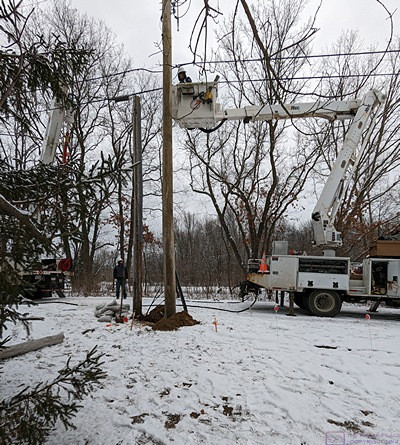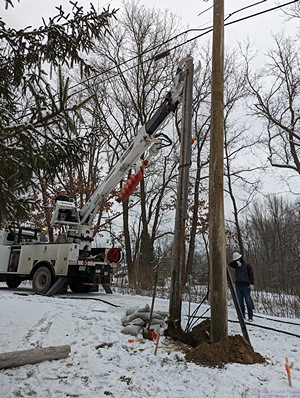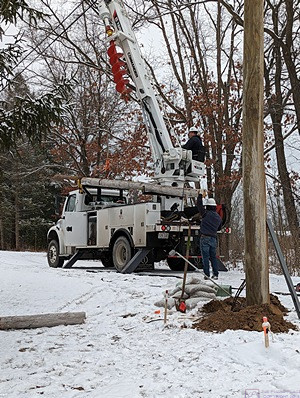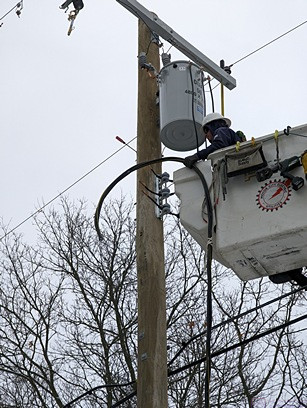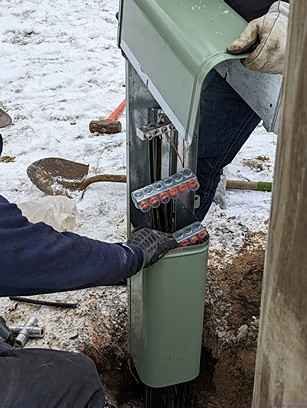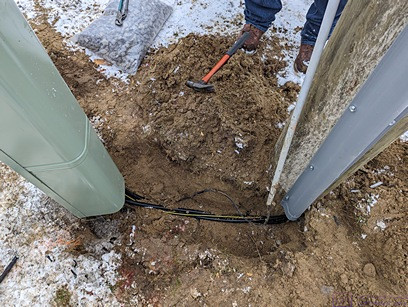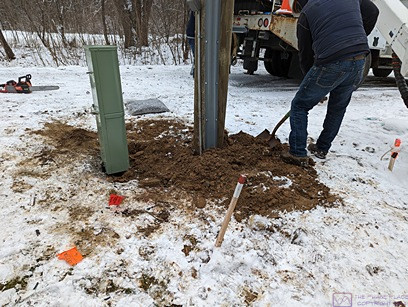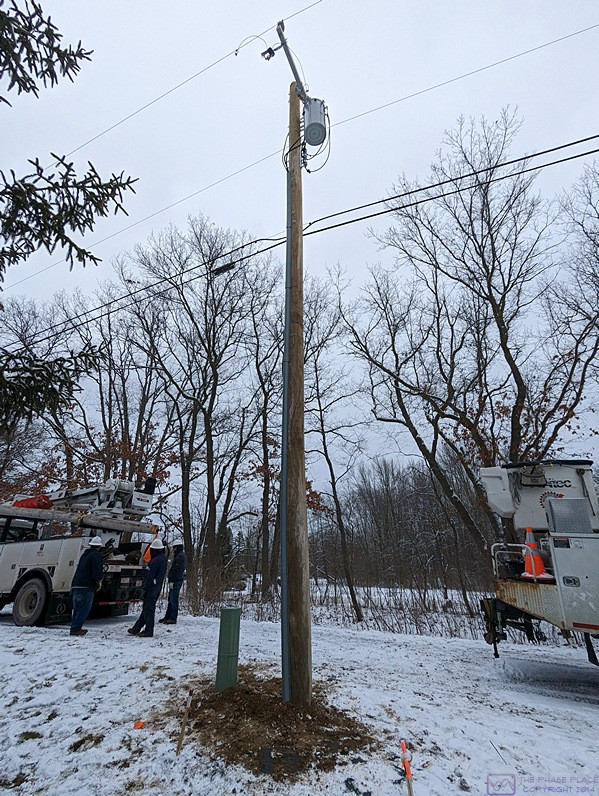[ There are 19 photos in this post. ]
MONDAY 23 January
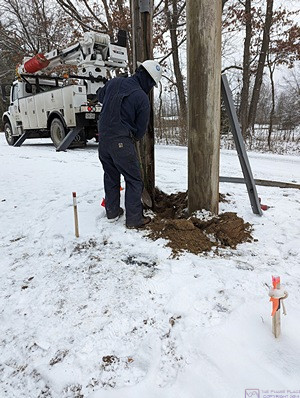
Digging to find the underground service conductors and the AT&T cable from the house. The wooden stake with the red tip, behind the crew member, is where our DTE planning consultant thought the ground pedestal should (might) be located. The stake to the right, with the orange top, marks the location of the free end of the 2” Schedule 40 PVC electrical conduit that Marty and I installed back on November 22nd. A comparison with the three (3) previous special blog posts makes in clear that we had snow yesterday. Still, the crew said the ground was not frozen and was easy to dig. They extended their digging from the old pole to the new one, as new wires would be run in that area.
I
did not expect work to be done on Sunday, and none was. I also did not know when a crew would be out next to continue the project, but I did not have to wait long to find out. Around 9:30 AM, a three-person crew showed up from Motor City Electric Utilities, a DTE contractor. They arrived with a crane/auger truck and a bucket truck, but they also had a trailer with a small excavator (back-hoe) with a 12” bucket.
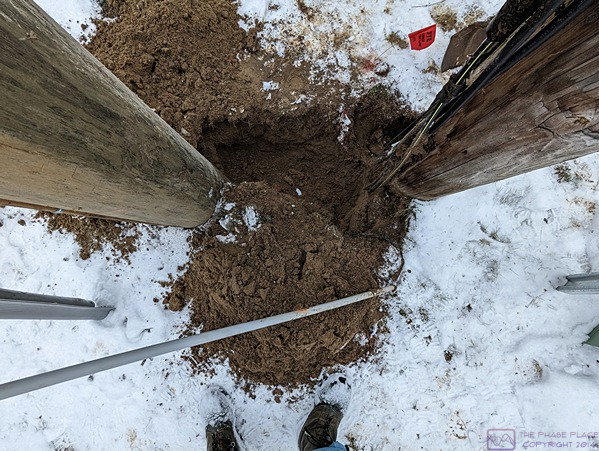
This photo is from the south facing north. The new pole is on the left. The existing underground service conductors from the house are clearly visible running up the old pole on the right. The AT&T cable is also visible at the right/lower end of the small PVC conduit lying on the ground.
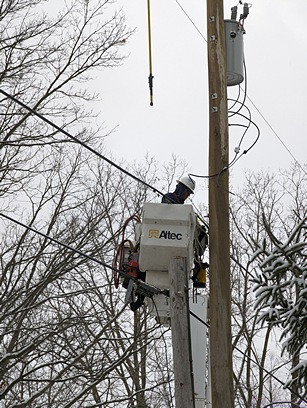
The insulated disconnect pole is hanging from the neutral distribution line after being used to disconnect power from the house. The crew member in the bucket is dis-mounting the Comcast cable from the old pole, using the bucket to lift it up, and mounting it to the new pole.
The first thing then did was start hand digging (with a shovel, obviously) by the old pole, looking for the underground service conductors from the house. The AT&T line to our house (no longer in service) also runs underground, along the same/parallel path as the power lines. (The service conductors for the house run underground from the meter, at the SW corner of the garage, to the old pole and then up to the transformer. I presumed these were one continuous run, but splices were eventually found underground at the base of the old pole.)
The next thing they did was open the disconnect switch so they could work safely around the conductors from the transformer secondary taps to the house. But first they worked on disconnecting the AT&T and Comcast cables from the old utility pole, raising them up, and securing them to the new pole. As part of this work, they had to route the existing AT&T cable down the new pole as best they could. (The Comcast/Xfinity cable comes to our house from a different pole in the SE corner of our yard.)
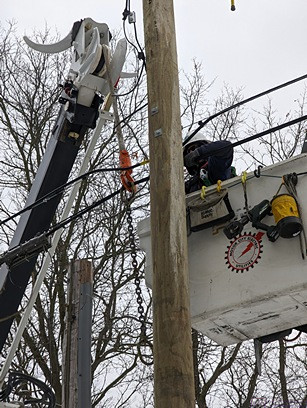
This crew used the hoist on the end of their crane truck to support and lift the broadband and phone cables. The latching hook is the orange thing visible near the center of the photo.
At this point, the existing house underground service conductors were disconnected from the new transformer and the old pole, and cut off about 4’ above where they exited the ground. The AT&T cable was also disconnected from the old pole, but not cut. (Note that our Comcast/Xfinity cable comes to our house from a different pole in the SE corner of our property.) With everything disconnected from the old pole, the crane truck was then used to pull it out of the ground then lay it down. It was then lifted and put on a pair of racks on the crane truck to be taken away. The hole left by the old pole was partially filled in, but was reused to install the new ground pedestal (junction box).
The crew had decided early on that they were going to install the new ground pedestal (junction box) in the hole left by the old pole. At this point, they dug up the underground service conductors from the house for a few feet back from the pedestal location. A new cable assembly, consisting of three (3) 350 kcmil conductors, was then routed down the new pole to provide the service drop to the pedestal. (At 350 thousand circular mils, these are big multi-strand conductors.)
At the upper end, the three wires were joined to the secondary transformer wires at the rack. The bottom end was left loose initially. The support post for the pedestal was then set into the ground and the conductors from the pole and the house positioned so the bottom pedestal cover could be attached. The two sets of wires were then spliced together using very large, insulated terminal blocks for the hots and an uninsulated junction block for the neutrals. The upper cover was put in place and secured, and all areas that were still excavated were filled back in.
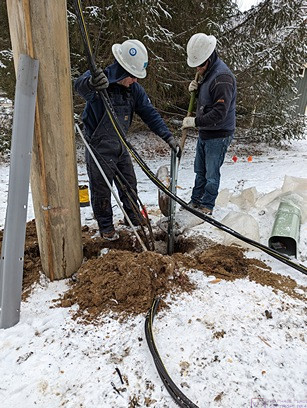
Two of the crew set the support post for the pedestal, part of which is lying on the ground to the right. The large 3-conductor 350 kcmil cable has not been cut to its final length, positioned underground, and secured to the new pole.
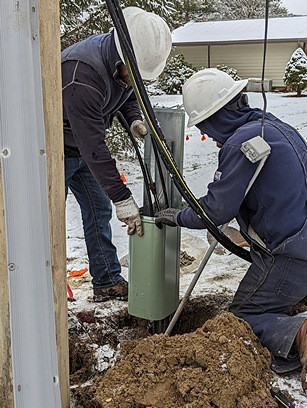
The underground service conductors from the house have been routed up into the bottom have of the pedestal and the crew is working to free the AT&T cable so they can move it out of the way and relocate it to the new pole.
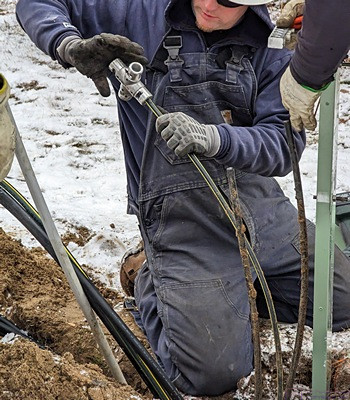
This X-shaped cable stripper was the biggest wire stripper I have ever seen. The house service conductors were 3/0 AWG, smaller than the 350 kcmil conductors the ran down the new pole, but still big. (The 350 kcmil conductors will supply power to both the house and the barn.)
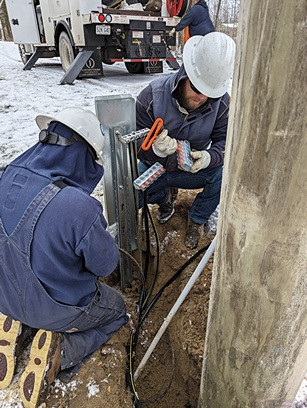
The junction blocks used to connect the cables together are visible in the center of the photo. The orange thing is the handle of a large T-style hex wrench. The junction blocks for the hot conductors are insulated, the one for the neutral is not.
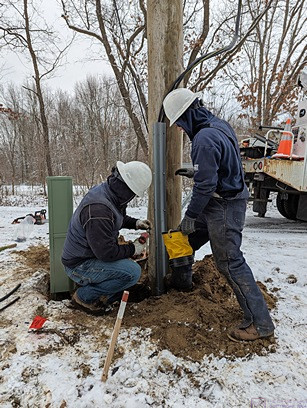
The 350 kcmil conductors are positioned underground and the first piece of protective PVC cover is secured to the pole.
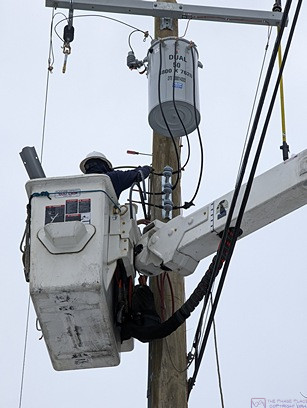
Using the bucket, the protective covering for the 350 kcmil cables was attached all the way to near the bottom of the rack. The conductors were then spliced together with the conductors from the transformer secondary taps at the rack.
Last, but not least, the disconnect switch was closed and utility power was restored to the house. I e-mailed our planning consultant and included photos of the ending status of the work.
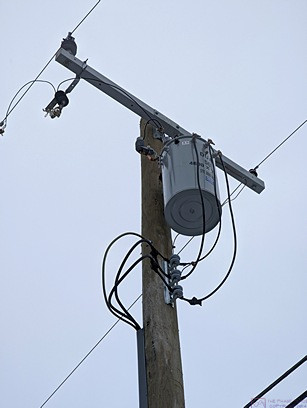
The finished installation connecting the new transformer/rack on the new pole to the new pedestal and the existing house underground service conductors. The disconnect switch has been closed, and the house is back on utility power.
Although the crew was done working on the DTE-related project of getting power to our barn, they were not done working at our property. The repositioned their equipment near the SE corner of our property and proceeded to grab one of the new 45’ utility poles from the ditch down the street and drag up to our place. They had a work order for this pole as well, and used their crane truck to pick it up and deposit it in our yard. They then spent a bit of time looking at the pole they had to replace. In the end, they left without doing anything else, but I don’t know why. Perhaps they did not have everything they needed, or it was just too late in the day to start. It looked like a tricky job to me, as power, phone and broadband lines T off at this pole and go across the street to the pole that supplies our neighbor’s house.
As always, I e-mailed our DTE planning consultant and included a few photos of the work.
…
